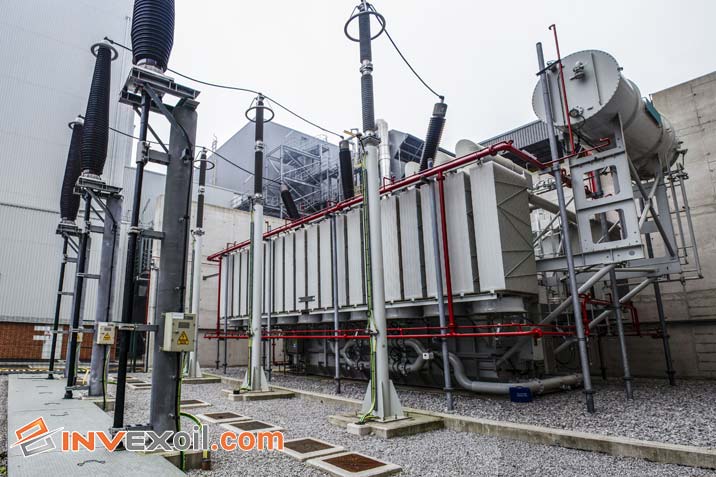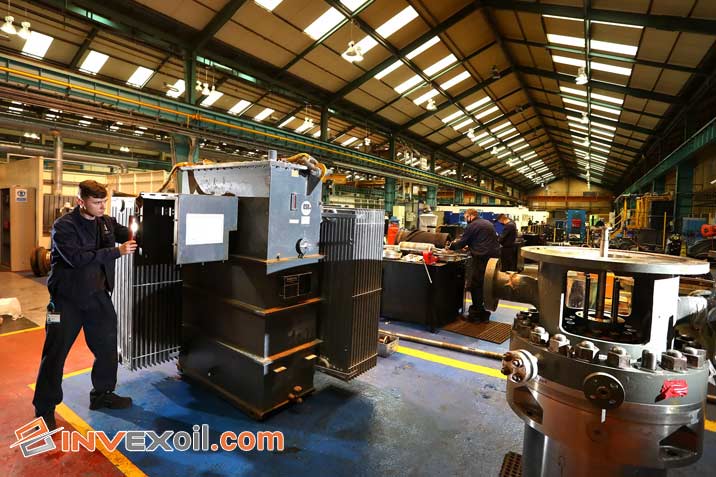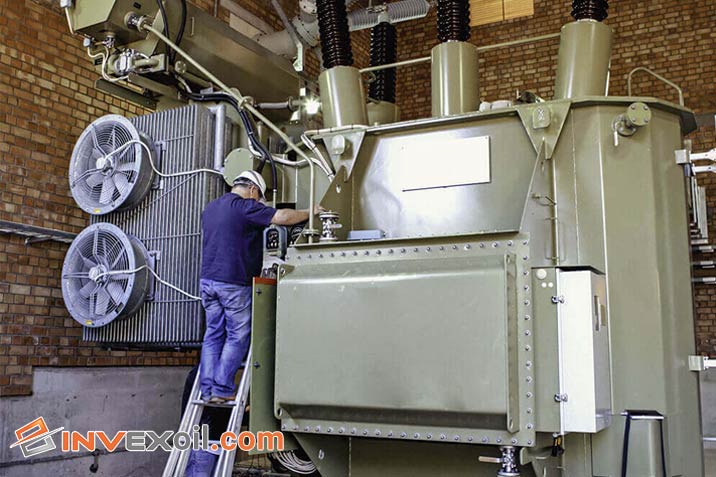Transformer oil maintenance is a vital practice in the oil, gas, and chemistry industry. Regular inspections, testing, and proactive measures are essential to prevent oil degradation, ensure optimal performance, and minimize risks. to prevent further deterioration of oil and possible damage to the active part of the transformer, oil needs to be regenerated in Transformer oil regeneration system. By adhering to scheduled checks, proper handling, and timely replacements, professionals safeguard transformer health, prevent costly disruptions, and enhance overall safety.
Table of Contents
Causes of Transformer Oil Deterioration
Effective transformer oil maintenance requires an understanding of why transformer oil deteriorates. A comprehensive examination of the following factors is necessary to understand the degradation process:
Development of Internal Pressure in the Oil
Internal pressure build-up within transformer oil can trigger a cascade of degradation effects. This is often caused by factors such as:
- Thermal Expansion: As the temperature rises during operation, the oil expands, leading to increased pressure inside the transformer.
- Gas Generation: The breakdown of oil molecules under high temperatures generates gases like hydrogen. Accumulated gas can intensify pressure, disrupting the oil’s stability.
Temperature Fluctuations during Operation
Temperature fluctuations are a critical concern in transformer oil maintenance. Here’s how they impact the oil’s quality and performance:
- Oil Oxidation: Higher temperatures can accelerate the oxidation of transformer oil, leading to a decrease in its dielectric strength and other properties.
- Increased Viscosity: Extreme temperature changes can cause the oil’s viscosity to fluctuate, affecting its ability to flow smoothly and provide proper insulation.
- Thermal Stress: Rapid temperature shifts cause thermal stress on the oil, potentially leading to the formation of sludge and other byproducts that impair its effectiveness.
Frequent Operating Voltage Changes
The voltage levels at which a transformer operates have a notable impact on its oil’s longevity:
- Oil Breakdown: Frequent voltage variations can lead to partial discharges within the transformer, causing stress on the oil and reducing its insulating properties.
- Accelerated Aging: Rapid voltage shifts can accelerate the oil’s aging process, diminishing its ability to maintain optimal performance.
- Chemical Reactions: Voltage fluctuations can trigger chemical reactions within the oil, resulting in the formation of undesirable byproducts that compromise its quality.
Testing Transformer Oil
In the realm of transformer oil maintenance, routine testing stands as a cornerstone. These tests are paramount to ensuring the health and longevity of the transformer and its vital oil.
For optimal maintenance of transformer oil, conducting essential checks on a half-yearly basis (every 6 months) is crucial. These checks involve a comprehensive assessment of key parameters:
- Dielectric Strength: Determining the oil’s ability to insulate effectively.
- Water Content: Monitoring the presence of moisture, which can adversely affect performance.
- Acidity: Evaluating the oil’s acidity level, a key indicator of degradation.
- Sludge Content: Detecting the accumulation of unwanted sediments.
- Flash Point: Identifying the temperature at which the oil can ignite.
- DDA (Dissolved Gas Analysis): Analyzing the presence of gases dissolved in the oil, indicating potential faults.
- IFT (Interfacial Tension): Measuring the oil’s ability to separate from water.
- Resistivity: Gauging the oil’s electrical resistance.
Importance of Regular Testing
Regular testing serves as a preemptive measure against potential issues:
- Safety Assurance: Testing helps identify potential hazards and prevents untimely failures.
- Cost Optimization: Timely detection of oil deterioration allows for cost-effective maintenance.
- Operational Longevity: Well-maintained oil extends the lifespan of the transformer.
- Efficiency Enhancement: Monitoring oil quality ensures optimal performance and efficiency.
Importance of Transformer Oil Testing
Transformer oil testing is a pivotal practice in the realm of transformer oil maintenance, serving multiple crucial purposes:
1-Determining Essential Electrical Properties:
- Through testing, professionals assess the oil’s dielectric strength and its ability to insulate effectively.
- Detecting anomalies in electrical properties helps predict potential breakdowns, enabling timely preventive actions.
2-Assessing Suitability for Future Use:
- Testing gauges the oil’s overall health, helping professionals decide whether the oil is fit for continued use or if replacement is necessary.
- This evaluation ensures that the transformer operates with optimal insulation, promoting safe and efficient functioning.
3-Detecting the Need for Regeneration or Filtration:
- Oil regeneration or filtration can be costly endeavors. Regular testing helps identify when such interventions are truly necessary, saving resources.
4-Reducing Operational Costs and Enhancing Component Longevity:
- By catching problems early on, testing prevents larger and more expensive issues from arising.
- This not only conserves operational expenses but also extends the lifespan of the transformer and its components.
5-Preventing Untimely Failures and Maximizing Safety:
- Early detection of potential issues prevents sudden failures that can lead to downtime and costly repairs.
- Ensuring the safety of personnel and the surrounding environment is a paramount outcome of routine testing.
Various Transformer Oil Testing Methods
In the realm of transformer oil testing, a range of techniques empowers professionals to evaluate the oil’s health and effectiveness:
- Visual Analysis: A basic assessment of the oil’s color and clarity, which can indicate contamination or degradation.
- Dielectric Breakdown Voltage (BDV Test): Measures the voltage at which the oil’s insulating properties fail, indicating potential risks.
- Color Analysis: Monitors changes in oil color, which can reveal oxidation and degradation.
- Dissolved Gas Analysis (DGA Test): Detects gases dissolved in the oil, offering insights into developing faults.
- Flash Point or Fire Point: Determines the temperature at which the oil can ignite, ensuring safety.
Transformer Diagnostic and Monitoring
Regular diagnostics and monitoring play a pivotal role in maintaining the health and functionality of transformers. This proactive approach ensures the early detection of potential issues, preventing untimely failures and disruptions. Here’s a comprehensive checklist for hourly inspections:
Hourly Inspections
- Winding Temperature: Continuous monitoring of winding temperature prevents overheating and identifies abnormal conditions that may lead to insulation breakdown.
- Ambient Temperature: Gauging the ambient temperature helps contextualize the transformer’s operating conditions and potential impacts on its performance.
- Oil Temperature (unless it’s a dry-type transformer): Monitoring oil temperature is crucial as it reflects the transformer’s overall health and cooling system efficiency.
- Load in Amps: Keeping track of load currents aids in understanding the transformer’s power consumption and performance under varying conditions.
- Voltage: Consistently measuring the voltage levels helps identify deviations that might indicate issues in the electrical supply or transformer performance.
| Parameter | Normal Range | Abnormal Range |
| Winding Temperature | 50°C – 80°C | Above 80°C or below 50°C |
| Ambient Temperature | Varies based on environment | Extreme temperature fluctuations |
| Oil Temperature | 25°C – 70°C | Above 70°C or below 25°C |
| Load in Amps | Expected load range | Significantly higher or lower |
| Voltage | Standard voltage range | Voltage spikes or drops |
Daily Inspections
Regular and comprehensive inspections on a daily basis are crucial to ensure the optimal performance and safety of transformers. Here’s a checklist of essential daily inspections:
| Component | Inspection Purpose |
| Transformer Oil Level | Prevent operational issues |
| Bushing Oil Level | Maintain insulation and efficiency |
| OLTC Conservator Oil Level | Ensure smooth OLTC operation |
| Dehydrating Breather | Control moisture and air circulation |
| Relief Diaphragm | Prevent pressure buildup |
| Cooling Fan | Prevent overheating |
| Bearing Motor | Maintain proper function |
| Operating Mechanism | Prevent malfunctions |
Quarterly or Every Four Months
Regular quarterly inspections are crucial for transformer longevity and reliability. This includes:
- Bushing Maintenance: Cleaning and inspecting bushings to ensure optimal performance.
- Quality Check on Transformer Oil: Ensuring that the oil’s quality remains within acceptable standards.
| Component | Inspection Purpose |
| Bushing Maintenance | Optimize bushing performance |
| Quality Check on Transformer Oil | Maintain oil quality |
End of 5000 Operations
At the end of approximately 5000 operations or on a yearly basis, the following inspections are imperative:
OLTC Diverter Switch Oil Check: Ensuring the proper functioning of the diverter switch’s oil.
Items that need to be checked yearly:
Yearly inspections encompass a comprehensive assessment of critical components:
| Component | Inspection Purpose |
| Comprehensive Transformer Oil Check | Analyze oil health and quality |
| Oil-Filled Condenser Bushing Inspection | Check condenser bushing condition |
| Gasket Joint Inspection | Prevent leaks from improperly sealed joints |
| Cable Box Check | Ensure cable box functionality and safety |
| Relay, Alarm, and Circuit Inspection | Verify operational readiness |
| Painting Assessment | Identify and prevent corrosion |
| Earth Resistance Test | Ensure proper grounding for safety |
Maintaining and Replacing Transformer Oil
Proper maintenance and timely oil replacement are fundamental to ensuring the longevity and reliability of transformers. This section delves into the essential methods for achieving these goals, complemented by insightful charts and images.
Preventative Maintenance and Risk Mitigation
Taking a proactive stance towards preventing oil loss and mitigating potential risks is paramount. Here’s a closer look at the measures to adopt:
-
Regular Inspections and Oil Sampling:
- Scheduled inspections and oil sampling help detect early signs of oil degradation or leaks.
- These practices enable professionals to intervene before minor issues escalate into major problems.
-
Proper Storage and Handling of Transformer Oil:
- Ensuring proper storage conditions and handling procedures prevent contamination and deterioration.
- Following best practices in storage safeguards the oil’s quality for optimal performance.
-
Repairs and Replacements of Damaged Components:
- Identifying and promptly repairing or replacing damaged components prevents further deterioration.
- This approach minimizes the risk of cascading failures and subsequent operational disruptions.
-
Contingency Plans and Emergency Response Procedures:
- Having well-defined contingency plans in place prepares for unexpected oil-related emergencies.
- These procedures ensure swift and effective actions to minimize potential safety hazards.
| Preventative Measure | Purpose |
| Regular Inspections and Oil Sampling | Early detection and intervention for oil issues |
| Proper Storage and Handling of Transformer Oil | Prevent contamination and maintain oil quality |
| Repairs and Replacements of Damaged Components | Prevent further deterioration and operational issues |
| Contingency Plans and Emergency Response Procedures | Swift response to oil-related emergencies |
Embracing these measures empowers professionals to uphold transformer health, optimize performance, and minimize risks.
Conclusion
In the realm of transformer oil maintenance, understanding the causes of deterioration is essential for optimal performance. Factors like internal pressure, temperature fluctuations, and voltage changes can compromise oil quality over time. By comprehending these influences and taking proactive measures, professionals can ensure prolonged transformer health. This knowledge empowers effective maintenance practices, safeguarding equipment, enhancing reliability, and reducing the risk of untimely failures. Stay informed, implement preventative actions, and secure the longevity of your transformers.
FAQ
Now, there are some most common questions about this article, and you can read them to find your answers:
What is transformer oil maintenance?
Transformer oil maintenance refers to the regular inspection, testing, and care of transformer oils to ensure optimal performance and longevity.
Why does transformer oil deteriorate?
Transformer oil deteriorates due to factors like internal pressure, temperature fluctuations, and voltage changes, which affect its insulating properties over time.
How often should transformer oil be tested?
Transformer oil should be tested routinely, including yearly checks for parameters like dielectric strength, water content, acidity, and more.

Hello, This is Matteo Hudson Copywriter from InvexOil. We are here to provide super-important content to help you learn more easily and be involved in the world of Petroleum and Chemistry. We are here to answer your questions, help you to have better services, and also find the best solution for your problems. Don’t be shy and ask your questions in the comment box or call our number. If you want to connect with me directly, you can search for my name on Linkedin.







